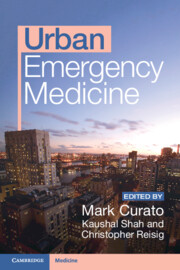Book contents
- Urban Emergency Medicine
- Urban Emergency Medicine
- Copyright page
- Contents
- Contributors
- Preface
- Chapter 1 Caring for the Homeless
- Chapter 2 Disruptive and Dangerous Agitation
- Chapter 3 Penetrating Trauma
- Chapter 4 Substance Use
- Chapter 5 Human Trafficking
- Chapter 6 Travelers from Overseas
- Chapter 7 HIV, AIDS, and Tuberculosis
- Chapter 8 Asthma
- Chapter 9 Physician/Patient Discordance
- Chapter 10 LGBTQIA+ Care
- Chapter 11 Child Maltreatment
- Chapter 12 Care of Vulnerable Elders
- Chapter 13 Civil Unrest: Caring for Police and Protesters
- Chapter 14 Terrorism and Mass Casualty Incidents
- Chapter 15 Overcrowding, Triage, and Care Rationing
- Index
- References
Chapter 1 - Caring for the Homeless
Published online by Cambridge University Press: 20 July 2023
- Urban Emergency Medicine
- Urban Emergency Medicine
- Copyright page
- Contents
- Contributors
- Preface
- Chapter 1 Caring for the Homeless
- Chapter 2 Disruptive and Dangerous Agitation
- Chapter 3 Penetrating Trauma
- Chapter 4 Substance Use
- Chapter 5 Human Trafficking
- Chapter 6 Travelers from Overseas
- Chapter 7 HIV, AIDS, and Tuberculosis
- Chapter 8 Asthma
- Chapter 9 Physician/Patient Discordance
- Chapter 10 LGBTQIA+ Care
- Chapter 11 Child Maltreatment
- Chapter 12 Care of Vulnerable Elders
- Chapter 13 Civil Unrest: Caring for Police and Protesters
- Chapter 14 Terrorism and Mass Casualty Incidents
- Chapter 15 Overcrowding, Triage, and Care Rationing
- Index
- References
Summary
Although homelessness is a societal problem across the US, 60% of people experiencing homelessness are located in urban centers. Structural factors such as lack of affordable housing are the central drivers of urban homelessness, rather than migration patterns or individual characteristics such as substance use and mental illness. Unhoused individuals have a larger burden of disease compared to the general population, with higher mortality rates even when controlling for other factors. Although emergency departments provide access to some of the lowest barrier health care in urban areas, unhoused patients are more susceptible to deviations from the standard of care. Clinicians risk making biased or uninformed triage and treatment decisions for this patient population, which creates the potential for poor clinical outcomes. Emergency clinicians should treat people experiencing homelessness with respect and provide an appropriate evaluation and disposition as determined by presenting complaint as well as associated health and social needs. In addition to clinical care, EDs can provide people experiencing homelessness with connection to support services to improve health outcomes.
- Type
- Chapter
- Information
- Urban Emergency Medicine , pp. 1 - 12Publisher: Cambridge University PressPrint publication year: 2023



